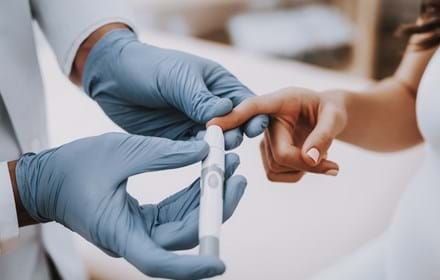
Pharmacists, nurses and educators offer better treatment options for people with type 2 diabetes
Pharmacists, nurses and educators offer better treatment options for people with type 2 diabetes
Researchers from UK and US recommend better advice should be available to help people living with the condition to control blood glucose levels. Taking the role of sole medical guidance from doctors in favour of a wider network of pharmacists, nurses and diabetes educators could be an effective way to share recommendations to help reduce blood glucose levels in people with type 2 diabetes, according to the findings of an international study. Researchers identified that therapeutic inertia is where care stagnates, defined as the failure to establish appropriate targets and escalate treatment to achieve treatment goals.
The results of the Overcoming Therapeutic Inertia study were recently published in Diabetes, Obesity and Metabolism and included findings from researchers from Leicester in the UK and California, Virginia, New Jersey, Utah, Arizona, Texas, Ohio and Alabama in the U.S. and the American Diabetes Association (ADA). The study was led by Professor Kamlesh Khunti and investigated the effect of interventions to overcome clinical inertia on glycaemic control in type 2 diabetes, focusing on reduction of HbA1c (blood glucose levels).
It was the first systematic review on overcoming therapeutic inertia and in addition to journal publication, the results were simultaneously shared at the ADA’s virtual 81st Scientific Sessions conference. Dr Robert Gabbay, Chief Scientific and Medical Officer for the ADA, said: “The American Diabetes Association is spearheading an effort to overcome therapeutic inertia to improve the outcomes for all people living with diabetes.
This important publication summarises what works and will help drive improvement in care for generations to come.” In their report, researchers said: “The most effective approaches to mitigating therapeutic inertia and improving HbA1c were those that empower nonphysician providers such as pharmacists, nurses and diabetes educators to initiate and intensify treatment independently, supported by appropriate guidelines.” After an extensive look at the available published research from 36 studies, researchers examining the impact of interventions introduced by different types of healthcare professionals to address therapeutic inertia.
The researchers categorised a series of possible interventions that included:
- Pharmacist-based interventions – including medication reviews and make guideline-based adjustments to medications.
- Care management and patient education interventions – looking at virtual coaching, or patient education, often supported by remote or telemonitoring.
- Physician-based interventions – focused on education in-person, written educational materials.
- Nurse- or certified diabetes educators-based interventions – using evidence-based protocols to provide diabetes management including treatment initiation or intensification.
Researchers found that a common characteristic of medication management initiatives led by either nurses, certified diabetes educators (CDE) or pharmacists was their ability to “independently initiate and intensify treatment” as long as they were supported by appropriate guidelines, protocols and collaborative agreements.
The study reported that only one of seven physician-based interventions was associated with a significantly greater reduction in mean HbA1c compared to usual care. However, researchers concluded that all of the nurse and CDE-based and pharmacist- based interventions “were effective” at reducing HbA1c. In summary, researchers said: “Nurse- and CDE-based interventions were associated with greater reductions in HbA1c compared to controls, with a mean HbA1c difference ranging from −17.7 mmol/mol (−1.62%) to −4.4 mmol/mol (−0.40%), while for pharmacist-based interventions reductions ranged from −9.8 mmol/mol (−0.90%) to −6.6 mmol/mol (−0.60%). “Corresponding estimates for care management and patient education interventions and for physician-based interventions were −13.1 mmol/mol (−1.20%) to 3.3 mmol/mol (0.30%) and −4.4 mmol/mol (−0.40%) to 2.8 mmol/mol (0.26%), respectively.”
Professor Kamlesh Khunti, Director of NIHR ARC East Midlands and Professor of Primary Care Diabetes and Vascular Medicine at the University of Leicester, said: “Despite the availability of effective treatment options and well-established management guidelines, corresponding improvement in reaching glycaemic targets has lagged. “The failure of healthcare providers to initiate or intensify treatment when indicated, or to deescalate therapy when appropriate known as therapeutic inertia is a contributing factor to the gap between population health goals for diabetes and current outcomes. That is why this study is so important because we look how best to address this challenge.”
NIHR ARC East Midlands funds vital work to tackle the region’s health and care priorities by speeding up the adoption of research onto the frontline of health and social care. The organisation puts in place evidence-based innovations which seek to drive up standards of care and save time and money.
Read the report in Diabetes, Obesity and Metabolism
Support DRWF by making a donation here
Find out more about DRWF-funded research here
Find out more about DRWF fundraising here
For latest update follow DRWF on Facebook, Instagram and Twitter
To receive the charity’s latest bulletins as they become available, please sign up here
Read DRWF diabetes information leaflets here
Join the Diabetes Wellness Network here
Recent News


